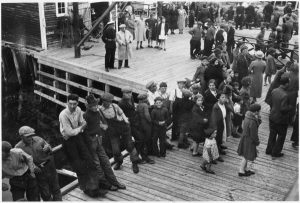ARCHIVAL MOMENT
May 23, 1869
On (May 23, 1869) Edward Morris of St. John’s wrote in his diary about all of the activity at the dockside in St. John’s . He observed “about 500 men” getting ready to leave Newfoundland in search for work. He wrote in his diary:
“Yesterday the “Merlin” Steamer left Shea’s Wharf for Nova Scotia with upwards of 500 men to work on the inter colonial railway. The saddest evidence of the depressed state of this colony (Newfoundland) that has as yet been presented. When the able and the young go away to work upon the roads in the other provinces in preference to remaining to prosecute the fisheries it speaks little for the inducements of the fisherman’s occupation.”
The jobs that the 500 Newfoundlanders were seeking by taking the Steamer ‘Merlin from St. John’s to Nova Scotia were jobs on the inter colonial railway, under construction, linking the Maritime colonies and Canada. Completion of the railway was made a condition of Confederation in 1867.
The out migration, that Edward Morris witnessed, by his fellow Newfoundlanders is a constant theme in Newfoundland history. The people of Newfoundlandand moved to other countries for a wide range of reasons throughout the 1800’s, emigration occurred on the largest scale during the last two decades of the century when the cod fishery fell into severe decline and caused widespread economic hardship.
While some people left their homes permanently, others worked in foreign countries on a seasonal or temporary basis before returning home. Most emigrants moved to Canada or the United States. The vast majority to “the Boston States.”
In more recent years Newfoundland and Labrador has witnessed (1996 and 2001) about 47,100 people pulling up stakes and leaving the province.
According to Statistics Canada estimates Newfoundland and Labrador experienced a net loss of 3,000 people to Ontario, Alberta and Nova Scotia in 2017-18.
The Conference Board of Canada’s most recent long-term forecast predicts the province’s population will fall from about 527,000 now to 482,000 by 2035.
Recommended Archival Collection: What do we have in the ‘Rooms Archives’ on this subject? Type emigration in the search bar here: http://gencat1.eloquent-systems.com/webcat/request/DoMenuRequest?SystemName=The+Rooms+Public&UserName=wa+public&Password=&TemplateProcessID=6000_3355&bCachable=1&MenuName=The+Rooms+Archives
Recommended Reading: Newfoundland: Journey Into a Lost Nation by Michael Crummey and Greg Locke. McClelland & Stewart. Chronicles the passage of a time when cod were still plentiful and the fishery shaped the lives of most of the island’s inhabitants, to the present, when an economy, propelled by oil and mineral development, is recasting the island’s identity in a new mould.
Recommended Website: Statistics Canada – http://www5.statcan.gc.ca/subject-sujet/theme-theme.action?pid=3867&lang=eng&more=0

